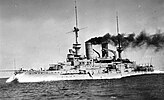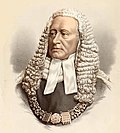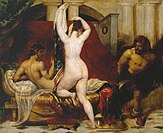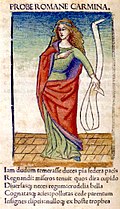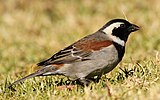| << | Today's featured articles for January 2018 | >> | ||||
|---|---|---|---|---|---|---|
| Su | Mo | Tu | We | Th | Fr | Sa |
| 1 | 2 | 3 | 4 | 5 | 6 | |
| 7 | 8 | 9 | 10 | 11 | 12 | 13 |
| 14 | 15 | 16 | 17 | 18 | 19 | 20 |
| 21 | 22 | 23 | 24 | 25 | 26 | 27 |
| 28 | 29 | 30 | 31 | |||
January 1
Joe Warbrick (1 January 1862 – 30 August 1903) was a Māori rugby union player. The youngest person ever to play first-class rugby in New Zealand, he was selected as a 15-year-old to play fullback for Auckland Provincial Clubs. In 1884 he made the first New Zealand representative team, and appeared in seven of their eight matches on their tour of New South Wales. Four years later he conceived of, selected, and led the privately funded New Zealand Native football team, which eventually included several New Zealand-born and foreign-born Europeans. Although the team played 107 matches, including 74 in the British Isles, Warbrick took part in only 21 matches due to injury. The tour, the first from the Southern Hemisphere to visit Britain, remains the longest in rugby's history. In 2008 Warbrick and the Natives were inducted into the World Rugby Hall of Fame. He effectively retired from rugby after returning from the tour, except for one appearance for Auckland in 1894, and went on to work as a farmer and tourist guide in the Bay of Plenty. In 1903 he was killed along with several others by an eruption of the Waimangu Geyser. (Full article...)
January 2
Lawrence Wetherby (January 2, 1908 – March 27, 1994) was a Lieutenant Governor (1947–1950) and Governor (1950–1955) of the U.S. Commonwealth of Kentucky. As governor, he helped increase funding for education, government benefits, road construction, and industrial diversification. He endorsed the Supreme Court's 1954 desegregation order in the case of Brown v. Board of Education and appointed a biracial commission to oversee the successful integration of the state's schools. As chair of the Southern Governors Conference in 1954 and 1955, he encouraged other southern governors to accept and implement desegregation. Wetherby was limited to one term by the state constitution. He ran for the US Senate in 1956, but his successor as governor, fellow Democrat A. B. "Happy" Chandler, failed to support his campaign, and he lost to Republican John Sherman Cooper. From 1964 to 1966, Wetherby served on a commission charged with revising the state constitution, and in 1966 he was elected to the Kentucky Senate, where he provided leadership in drafting the state budget. After retiring from politics, he became an executive at Brighton Engineering. (Full article...)
January 3
The red-backed fairywren (Malurus melanocephalus) is a species in the Australasian wren family, Maluridae. It is endemic to Australia and can be found near rivers and coastal areas along the northern and eastern coastlines from the Kimberley in the northwest to the Hunter Region in New South Wales. Most males adopt a striking breeding plumage, with brown wings, a brightly coloured red back, and a black head, upperparts and tail. Females, juveniles, and some males have brownish upperparts and paler underparts. The species mainly eats insects, and supplements its diet with seed and small fruits. The preferred habitat is heathland and savannah, particularly where low shrubs and tall grasses provide cover. A group consists of a socially monogamous pair with one or more grown offspring who assist in raising the young. The red-backed fairywren is sexually promiscuous, and each partner may mate with other individuals. As part of a courtship display, the male wren plucks red petals from flowers and displays them to females. (Full article...)
January 4
Lilias Armstrong (1882–1937) was an English phonetician. Her book on English intonation, written with Ida C. Ward, was in print for fifty years. She also provided some of the first detailed descriptions of tone in Somali and Kikuyu. Armstrong grew up in Northern England. She graduated from the University of Leeds, where she studied French and Latin. She taught French in an elementary school in the London suburbs before joining the University College Phonetics Department, headed by Daniel Jones, where she was eventually appointed as a reader. Her works include the 1926 book A Handbook of English Intonation (co-written with Ward), the 1934 paper "The Phonetic Structure of Somali", and the book The Phonetic and Tonal Structure of Kikuyu, published posthumously in 1940. She was the subeditor of the International Phonetic Association's journal Le Maître Phonétique for more than a decade, and was praised in her day for her teaching. Jones wrote in his obituary of her that she was "one of the finest phoneticians in the world". (Full article...)
January 5
Holy Wood (In the Shadow of the Valley of Death) is the fourth studio album by American rock band Marilyn Manson, released in November 2000 by Nothing and Interscope Records. A rock opera concept album, it is the final installment of a triptych that included Antichrist Superstar (1996), marking a return to the band's industrial metal style. The album was released to generally positive reviews; some praised it as the band's finest work, and multiple publications ranked it as one of the best albums of 2000. British rock magazine Kerrang! later included it on its list of the best albums of the decade. Holy Wood was not as commercially successful in the US as the band's preceding records, debuting at number 13 on the Billboard 200, but it became their most successful album internationally, and made the top twenty of numerous national charts. It was certified gold in several countries, including Canada, Japan, Switzerland and the UK. Three singles were released from the record: "Disposable Teens", "The Fight Song" and "The Nobodies". The album was covered on the band's worldwide Guns, God and Government Tour. (Full article...)
January 6
The Three Sisters are volcanic peaks of the Cascade Volcanic Arc in Oregon in the northwestern United States. More than 10,000 feet (3,000 m) in elevation, they are the third-, fourth-, and fifth-highest peaks in Oregon. They are about 10 miles (16 km) south of the nearest town, Sisters, in the Three Sisters Wilderness. The three mountains, particularly South Sister, are popular destinations for climbing and scrambling. They are subject to frequent snowfall, occasional rain, and extreme temperature variation between seasons. Although they are often grouped together as a complex volcano, the three mountains differ in geology and eruptive history. Neither North Sister nor Middle Sister has erupted in the last 14,000 years. South Sister last erupted about 2,000 years ago, and there are indications it could erupt again. After satellite imagery detected tectonic uplift near South Sister in 2000, the United States Geological Survey improved monitoring in the immediate area. (Full article...)
January 7
William of Wrotham (died c. 1217) was a medieval English royal administrator and clergyman. Hubert Walter, who was the Archbishop of Canterbury and the king's chief minister, gave William responsibility for the royal tin mines in 1197, and the following year he was placed in charge of tin production, an office later known as the Lord Warden of the Stannaries. William also held ecclesiastical office, eventually becoming Archdeacon of Taunton, and served King John of England as an administrator of ecclesiastical lands and a collector of taxes. He was in charge of the royal fleet in the south of England from 1206 until 1215, and was one of those responsible for the development of Portsmouth as a naval dockyard. He is usually given the title of "keeper of ports" or "keeper of galleys", probably a forerunner of the office of First Lord of the Admiralty. By 1215 William had joined the First Barons' War against John, but returned to the royalist cause after John's death in 1216. The medieval chronicler Roger of Wendover called him one of John's "evil advisers", but modern historians say Roger's account was exaggerated. (Full article...)
January 8
The periodic table is a chart of the chemical elements, ordered by atomic number and electron configuration. The elements in each group (column) often have similar chemical properties. The table also shows four rectangular blocks with some similarities in physical and chemical properties. Six groups have generally accepted names, including the halogens of group 17 and the noble gases of group 18. The table provides a framework for analyzing chemical behaviour, and is extensively used in chemistry and other sciences. The Russian chemist Dmitri Mendeleev published the first widely recognized periodic table in 1869, and correctly predicted some properties of then-unknown elements that would be expected to fill in the gaps. Mendeleev's periodic table has been expanded and refined over time; elements 1–94 have all been found to occur naturally, and elements 95–118 have been synthesized in nuclear reactors or laboratories. (Full article...)
January 9
Der 100. Psalm (The 100th Psalm), Op. 106, is a composition in four movements by Max Reger in D major for mixed choir and orchestra, a late Romantic setting of Psalm 100. Reger began composing the work in 1908 for the 350th anniversary of Jena University. It premiered simultaneously on 23 February 1910 in Chemnitz, conducted by the composer, and in Breslau, conducted by Georg Dohrn. Reger structured the text in four movements, as a choral symphony. He scored it for a choir of four to eight voices, a large symphony orchestra, and organ. Reger used late-Romantic features of harmony and dynamics, along with polyphony in the Baroque tradition. The last movement is a double fugue, with an instrumental cantus firmus of Luther's chorale "Ein feste Burg ist unser Gott" as its climax. The biographer Eugen Segnitz considered the work unique in the sacred music of its period, with a convincing musical interpretation of the biblical text and manifold shades of emotion. Paul Hindemith wrote a trimmed adaption that helped to keep the work in the repertory, and organ versions were written to make the work accessible for smaller choirs. (Full article...)
January 10
Hrithik Roshan (born 10 January 1974) is an Indian Bollywood actor. His first leading role was in his father Rakesh's Kaho Naa... Pyaar Hai (2000), a box-office success that earned him several awards. After a series of unsuccessful films, he starred in the 2003 science fiction film Koi... Mil Gaya, which proved a turning point in his career; he also appeared in its highly successful sequels: Krrish (2006) and Krrish 3 (2013). Roshan earned widespread praise for his roles in Dhoom 2 (2006), Jodhaa Akbar (2008) and Guzaarish (2010). Further success came with the 2011 drama Zindagi Na Milegi Dobara, the 2012 revenge film Agneepath, and Bang Bang!, a 2014 action comedy. One of the highest-paid actors in India, he has won many awards, including six Filmfares. He has also performed on stage, launched his own clothing line and debuted on television with Just Dance (2011). As a judge on the show, he became the highest-paid film star on Indian television. Roshan was married for fourteen years to Sussanne Khan, with whom he has two children. (Full article...)
January 11
Rochdale Cenotaph is a First World War memorial on the Esplanade in Rochdale, Greater Manchester, in the north west of England. Designed by Sir Edwin Lutyens, it is one of seven memorials in England based on his Cenotaph on Whitehall in London, and one of his more ambitious designs. The memorial was unveiled in 1922 and consists of a 10-metre (33 ft) pylon, topped by an effigy of a recumbent soldier, and Lutyens' characteristic Stone of Remembrance. A public meeting in February 1919 established a consensus to create a monument and a fund for the families of wounded servicemen. The meeting agreed to commission Lutyens to design the monument. His design for a bridge over the River Roch was abandoned after a local dignitary purchased a plot of land adjacent to Rochdale Town Hall and donated it for the site of the memorial. Lutyens revised his design, and Edward Stanley, 17th Earl of Derby, unveiled the memorial on 26 November 1922. It was upgraded to a Grade I listed structure in 2015, when Lutyens' war memorials were declared a national collection by Historic England. (Full article...)
January 12
The first season of True Detective, an American anthology crime drama television series created by Nic Pizzolatto, premiered on HBO on January 12, 2014, starring Matthew McConaughey, Woody Harrelson, Michelle Monaghan, Michael Potts, and Tory Kittles. The nonlinear narrative in eight episodes focuses on Louisiana State Police homicide detectives Rust Cohle (McConaughey) and Marty Hart (Harrelson) as they investigate the murder of prostitute Dora Lange in 1995. Seventeen years later, they must revisit the investigation, along with several other unsolved crimes. The first season explores themes of philosophical pessimism, masculinity, and Christianity; critics have analyzed the show's portrayal of women, its auteurist sensibility, and the influence of comics, weird fiction and horror fiction on its narrative. The episodes, directed by Cary Joji Fukunaga, were filmed in Louisiana. The series received positive reviews and garnered a Primetime Emmy Award nomination for Outstanding Drama Series and a Golden Globe Award for Best Miniseries or Television Film, along with other honors for writing, cinematography, direction, and acting. (Full article...)
January 13
SMS Wittelsbach (His Majesty's Ship Wittelsbach) was the lead ship of her class of pre-dreadnought battleships, built for the German Imperial Navy. She was the first capital ship built under the Navy Law of 1898, which was brought about by Admiral Alfred von Tirpitz. Wittelsbach was laid down in 1899 at the Wilhelmshaven Navy Dockyard and completed in October 1902, armed with a main battery of four 24 cm (9.4 in) guns and with a top speed of 18 knots (33 km/h; 21 mph). During World War I the ship served in the IV Battle Squadron, with limited non-combat duty in the Baltic Sea, including during the Battle of the Gulf of Riga in August 1915. By late 1915, crew shortages and the threat from British submarines forced the navy to withdraw older battleships like Wittelsbach. The ship then saw service in auxiliary roles, first as a training ship and then as a ship's tender. In 1919, after the war, she was converted to a tender for minesweepers. (Full article...)
Part of the Battleships of Germany featured topic.
January 14
State Route 94 (SR 94) is a 63.3-mile (101.9 km) highway in the U.S. state of California. The western portion, known as the Martin Luther King Jr. Freeway, begins at Interstate 5 (I-5) in downtown San Diego and continues to the end of the freeway portion past SR 125 in Spring Valley. The non-freeway segment of SR 94 that continues east through the mountains to I-8 near Boulevard is known as Campo Road. In the 19th and early 20th centuries, this section was a wagon road providing access to eastern San Diego County. The Campo road was often the only road through the Peninsular Ranges to stay open for the entire winter; other roads, at higher elevations, were closed due to snow, leading to increased traffic along this road. It was added to the state highway system in 1933, and signs for Route 94 were posted along local roads later that decade. Efforts to convert the western half of the route to a freeway got underway in the 1950s, and the freeway was complete by 1962 west of the road that became SR 125. (Full article...)
January 15
Ankylosaurus was an armored dinosaur that lived roughly 67 million years ago, at the very end of the Cretaceous Period. This genus was among the last of the non-avian dinosaurs, living alongside Tyrannosaurus, Triceratops, and Edmontosaurus. Its name means "fused lizard"; bones in its skull and other parts of its body were fused, increasing their strength. Ankylosaurus was up to 6.25 m (20.5 feet) long and 1.7 m (5.6 feet) tall, weighing about 4.8–8 tonnes (11,000–18,000 lb). It had a broad, robust body with a wide, low skull. The front parts of the jaws were covered in a beak, with rows of small, leaf-shaped teeth behind it, adapted for a herbivorous diet. It was covered in armor plates for protection against predators, with bony half-rings covering the neck, and had a large club on the end of its tail which may have been used as a weapon. Fossils from a few specimens of Ankylosaurus have been found in various geological formations in western North America, but a complete skeleton has not been discovered. (Full article...)
January 16
The Illinois Centennial half dollar is a commemorative fifty-cent piece struck by the United States Bureau of the Mint in 1918. The obverse side, depicting Abraham Lincoln, was designed by Chief Engraver George T. Morgan; the reverse image, based on the Seal of Illinois, was done by his assistant and successor, John R. Sinnock. Morgan's design is based on a statue by Andrew O'Connor. The State of Illinois asked for a commemorative to mark the centennial of its 1818 statehood. In 1918, after legislation was enacted, the two engravers produced designs, but Treasury Secretary William G. McAdoo required changes, not all of which were made. The coins were minted in August 1918, and were sold to the public for one dollar each. Though many were held by a bank until 1933, all were sold, and profits were used to cover the cost of local centennial celebrations or to help those in need because of World War I. Later writers have generally admired the coin, considering it one of the more handsome American commemoratives. It is valued in the hundreds of dollars today, and occasionally trades for more. (Full article...)
January 17
The Eastbourne manslaughter (R v Hopley) was an 1860 legal case in Eastbourne, England, about the death of a teenage pupil at the hands of his teacher, Thomas Hopley. Reginald Cancellor's parents gave Hopley permission to use corporal punishment to overcome what he perceived as the boy's stubbornness. After the boy died, the teacher insisted that the beating was justifiable and that he was not guilty of any crime. An inquest into Cancellor's death began when his brother requested an autopsy. As a result of the inquest Hopley was arrested and charged with manslaughter. Hopley's jury trial took place at Lewes Assizes, before Sir Alexander Cockburn (pictured), who was the Chief Justice of the Queen's Bench. Hopley was found guilty at trial and sentenced to four years in prison. In Cockburn's words, a schoolmaster "may for the purpose of correcting what is evil in the child, inflict moderate and reasonable corporal punishment". The trial was sensationalised by the Victorian press and incited debate over the use of corporal punishment in schools. Physical discipline was officially banned in British schools more than a century later. (Full article...)
January 18
Cleopatra Selene (died 69 BC) was a queen of Seleucid Syria (83–69 BC). The daughter of Ptolemy VIII and Cleopatra III of Egypt, she became the queen of Egypt in 115 BC when she was married to her brother, King Ptolemy IX, and later probably married King Ptolemy X. In 103 BC, Cleopatra III established an alliance with the Seleucid ruler Antiochus VIII; Cleopatra Selene was sent to be his bride, and stayed with him until his assassination in 96 BC. The widowed queen married her previous husband's brother, Antiochus IX, who died in 95 BC. She then married her stepson, Antiochus X, who probably died in 92 BC. She hid somewhere in Syria with her children until 83 BC, when the Seleucid thrones in Antioch and Damascus became vacant. Declaring her son Antiochus XIII king, she ruled alongside him, according to depictions on coins from the period. She was ousted when the people of Antioch and Damascus, exhausted by the Seleucids' civil wars, invited foreign monarchs as their new rulers. She then controlled several coastal towns until she was besieged, captured and executed in 69 BC by Tigranes in Ptolemais. (Full article...)
January 19
Sonic Spinball is a pinball video game developed by the Sega Technical Institute and published by Sega. It was originally released for the Mega Drive/Genesis in North America and Europe in November 1993 and in Japan the following month. It was later ported to the Game Gear and Master System in 1994 and 1995 respectively. The game has been re-released on eleven different consoles and has been included in Genesis-related compilations. The player controls Sonic the Hedgehog, who is manipulated like a pinball in various machine-like environments for most of the game, while the series antagonist Doctor Robotnik tries to enslave the population on the planet Mobius. Sonic Spinball was commissioned by Sega when it became clear that a new Sonic the Hedgehog game could not be completed in time for the 1993 holiday season, since the majority of their staff were developing Sonic the Hedgehog 3. The game was hastily developed, with most work completed within two months. It received mixed reviews upon release; most critics praised the game's novelty and graphics but faulted its control scheme. (Full article...)
January 20
Reg Pollard (20 January 1903 – 9 March 1978) was a senior commander in the Australian Army, serving as Chief of the General Staff from 1960 to 1963. He was mentioned in despatches in 1941 after seeing action with the 7th Division in the Middle East. In 1942 he became senior staff officer of the division in New Guinea, and was awarded the Distinguished Service Order for his actions. Pollard's early post-war roles involved recruit training, administration, and planning. In 1953 he took command of the Australian Army Component of the British Commonwealth Forces Korea. In 1957 he was promoted to lieutenant general and took charge of Eastern Command in Sydney. Knighted in 1961, he presided over the Army's reorganisation as Chief of the General Staff, and helped Royal Military College, Duntroon become a degree-granting institution. In 1962, he oversaw deployment of the first team of Australian military advisors to South Vietnam. After retiring from the military in 1963, Pollard became Honorary Colonel of the Royal Australian Regiment; he served as Australian Secretary to Queen Elizabeth II during the Royal Visit in 1970. (Full article...)
January 21
Saguaro National Park is a United States national park in southeastern Arizona that preserves Sonoran Desert landscapes, fauna, and flora, including the giant saguaro cactus. The 92,000-acre (37,000 ha) park has two separate areas—the Tucson Mountain District (TMD) about 10 miles (16 km) west of the city of Tucson and the Rincon Mountain District about 10 miles (16 km) east of the city. The Rincon Mountains are part of the Madrean Sky Islands between the southern Rocky Mountains and the Sierra Madre Oriental in Mexico; they are significantly higher and wetter than the Tucson Mountains, and support many plants and animals that do not live in the TMD. Earlier residents of and visitors to the lands in and around the park before its creation included the Hohokam, Sobaipuri, Tohono O'odham, and Apaches, as well as Spanish explorers, missionaries, miners, homesteaders, and ranchers. In 1933, President Herbert Hoover, using the Antiquities Act, established the original park, Saguaro National Monument, in the Rincon Mountains. In 1961, President John F. Kennedy added the TMD. (Full article...)
January 22
The S-50 Project was the Manhattan Project's effort to produce enriched uranium by liquid thermal diffusion during World War II. The process was developed by Philip H. Abelson and other scientists at the United States Naval Research Laboratory, and was one of three technologies for uranium enrichment pursued by the Manhattan Project. Pilot plants were built at the Anacostia Naval Air Station and the Philadelphia Navy Yard. A facility at the Clinton Engineer Works in Oak Ridge, Tennessee, was the only production-scale liquid thermal diffusion plant ever built. It could not enrich uranium sufficiently for use in an atomic bomb, but it could begin the process of enrichment that was completed by the Y-12 calutrons and the K-25 gaseous diffusion plants. It sped up the production of enriched uranium for the Little Boy bomb used in the atomic bombing of Hiroshima. This plant ceased production in September 1945, but was reopened in May 1946, and used by the Nuclear Energy for the Propulsion of Aircraft project of the US Army Air Forces before being demolished in the late 1940s. (Full article...)
January 23
Candaules, King of Lydia, Shews his Wife by Stealth to Gyges, One of his Ministers, as She Goes to Bed is a painting by English artist William Etty, first exhibited at the Royal Academy in 1830. It shows a scene from the Histories by Herodotus, in which Candaules, king of Lydia, invites his bodyguard Gyges to hide in the couple's bedroom and watch his wife Nyssia undress. After Nyssia notices Gyges, he kills Candaules and takes his place as king. The painting shows the moment at which Nyssia, unaware of Gyges, removes the last of her clothes. Etty hoped to impart the moral that women are not chattels and that men violating their rights should be punished, but he made little effort to explain this to audiences. The painting was immediately controversial, seen as a cynical combination of pornography and a violent unpleasant narrative, and critics condemned it as an immoral work of the type they would not expect from a British artist. In 1929 it was among several artworks transferred to the newly expanded Tate Gallery, where it remains. (Full article...)
January 24
August Meyszner (3 August 1886 – 24 January 1947) was an Austrian gendarmerie officer, right-wing politician, and senior Ordnungspolizei (order police) officer of Nazi Germany. He held the post of Higher SS and Police Leader in the German-occupied territory of Serbia from January 1942 to March 1944, during World War II. During his tenure, he oversaw regular reprisal killings and sent tens of thousands of forced labourers to Germany and occupied Norway. His Gestapo detachment also used a gas van to kill as many as 8,000 Jewish women and children who had been detained at the Sajmište concentration camp. Meyszner's time in Belgrade was characterised by friction and competition with German military, economic and foreign affairs officials, and by his visceral hatred and distrust of Serbs; he was considered one of Reichsführer-SS Heinrich Himmler's most brutal subordinates. Extradited by the Allies to Yugoslavia after the war, he was found guilty of war crimes by a military court, and was executed by hanging on 24 January 1947. (Full article...)
January 25
Lycoperdon perlatum, the common puffball, is a widespread species of fungus in the family Agaricaceae. It forms an off-white medium-sized puffball tapering to a wide stalk, 1.5 to 6 cm (0.6 to 2.4 in) wide by 3 to 10 cm (1.2 to 3.9 in) tall. Its top is covered in short spiny bumps that are easily rubbed off to leave a net-like pattern on the surface. When mature it becomes brown, and a hole in the top opens to release spores in a burst when the body is compressed by touch or falling raindrops. It is edible when the young internal flesh is completely white, but can be mistaken for an immature fruit body of several poisonous Amanita species. L. perlatum can usually be distinguished from similar puffballs by differences in surface texture. Its chemical compounds include the unusual amino acid lycoperdic acid and volatile sterol derivatives that give the puffball its flavor and odor. Laboratory tests indicate that extracts of the puffball have antimicrobial and antifungal activities. (Full article...)
January 26
The Australian Defence Force (ADF) comprises all of the country's armed forces, including the Royal Australian Navy, Australian Army, and Royal Australian Air Force. With a strength of just under 80,000 full-time personnel and active reservists, it is supported by the Department of Defence and other civilian agencies. During the first decades of the 20th century, the Australian Government established the armed services as separate organisations, each with an independent chain of command. In 1976, the government made a strategic change and established the ADF to place the three services under a single headquarters. The degree of integration has increased over time, and tri-service headquarters, logistics and training institutions have supplanted many single-service establishments. Technologically sophisticated, the ADF is the largest military in Oceania, with approximately 58,000 full-time active-duty personnel and 22,000 active reservists. It is smaller than many Asian militaries, but is supported by a significant budget by worldwide standards and can deploy forces in multiple locations outside Australia. (Full article...)
January 27
The Finnish Civil War (27 January – 15 May 1918) marked the transition from the Grand Duchy of Finland, part of the Russian Empire, to an independent state. Arising during World War I, it was fought between the Reds, led by the Social Democratic Party, and the Whites, led by the conservative Senate. In February 1918, the Reds carried out an unsuccessful offensive, supplied with weapons by Soviet Russia. A counteroffensive by the Whites began in March, reinforced by the German Empire's military detachments in April. The decisive engagements were the battles of Tampere and Vyborg, won by the Whites, and the battles of Helsinki and Lahti, won by German troops, leading to overall victory for the Whites and the German forces. The 39,000 casualties included political terror deaths. Although the Senate and Parliament were initially pressured into accepting the brother-in-law of German Emperor William II as the King of Finland, the country emerged within a few months as an independent, democratic republic. The war would divide the nation for decades. (Full article...)
January 28
Cento Vergilianus de laudibus Christi is a fourth-century Latin poem arranged by Faltonia Betitia Proba after her conversion to Christianity. A cento rearranges verses written by other poets; this one repurposes Virgil to tell stories from the Old and New Testament of the Christian Bible. Much of the work focuses on the story of Jesus Christ. The poem was widely circulated, eventually being used in schools to teach the tenets of Christianity, often alongside Augustine of Hippo's De Doctrina Christiana. Although the poem was popular, critical reception was mixed. A pseudonymous work purportedly by Pope Gelasius I disparaged the poem, deeming it apocryphal, and St. Jerome may have written disapprovingly of it, and of Proba. Other thinkers like Isidore of Seville, Petrarch, and Giovanni Boccaccio wrote highly of her, and many praised her ingenuity. During the 19th and 20th centuries the poem was considered a work of poor quality, but recent scholars have held it in higher regard. (Full article...)
January 29
In the Baltimore railroad strike of 1877, at least ten people were killed and more than 150 were injured. The unrest in Baltimore, Maryland, was part of a national railroad strike, following the global depression and economic downturns of the mid-1870s. On July 16, when the Baltimore and Ohio Railroad (B&O) scheduled 10 percent wage reductions, strikes broke out. Violence erupted in Baltimore on July 20, and police and soldiers of the Maryland National Guard clashed with crowds of thousands gathered throughout the city. In response, President Rutherford B. Hayes ordered federal troops to Baltimore, local officials recruited as many as 500 additional police, and two new national guard regiments were formed. Peace was restored two days later. Negotiations between strikers and the B&O were unsuccessful, and most strikers quit rather than return to work at reduced wages. The company easily found workers to replace the strikers, and rail traffic resumed on July 29 under the protection of the military and police. (Full article...)
January 30
Oviri is an 1894 ceramic sculpture by the French artist Paul Gauguin. It depicts a Tahitian goddess of mourning, with long pale hair and wild eyes. She smothers a wolf with her feet, while clutching a cub in her arms. Art historians have suggested multiple complex interpretations; its alternative title, "Savage", may refer to Gauguin's own view of himself. The work's form and tone was inspired by a number of ancient sources, including Majapahit mummies and an Assyrian relief of a master of animals. Other possible influences include preserved skulls from the Marquesas Islands, figures found at Borobudur, and a 9th-century Mahayana Buddhist temple in central Java. Gauguin made three casts, each in partially glazed stoneware. The original is housed at the Musée d'Orsay, in France. It was exhibited at the 1906 Salon d'Automne where it was seen by Pablo Picasso, who used it as the basis for one of the figures in his Les Demoiselles d'Avignon. (Full article...)
January 31
The Cape sparrow (Passer melanurus) is a southern African bird. A medium-sized sparrow at 14–16 centimetres (5.5–6.3 in), it has distinctive grey, brown, and chestnut plumage, with large pale head stripes in both sexes. The male has some bold black and white markings on its head and neck. The species inhabits semi-arid savannah, cultivated areas, and towns, from the central coast of Angola to eastern South Africa and Swaziland. Cape sparrows primarily eat seeds, along with soft plant parts and insects. They typically breed in colonies, and search for food in large nomadic flocks. The nest can be constructed in a tree, bush, cavity, or disused nest of another species. A typical clutch contains three or four eggs, and both parents are involved, from nest building to feeding the young. The species is common in most of its range and coexists successfully in urban habitats with two of its relatives, the native southern grey-headed sparrow and the house sparrow, an introduced species. The Cape sparrow's population has not decreased significantly, and is not seriously threatened by human activities. (Full article...)









